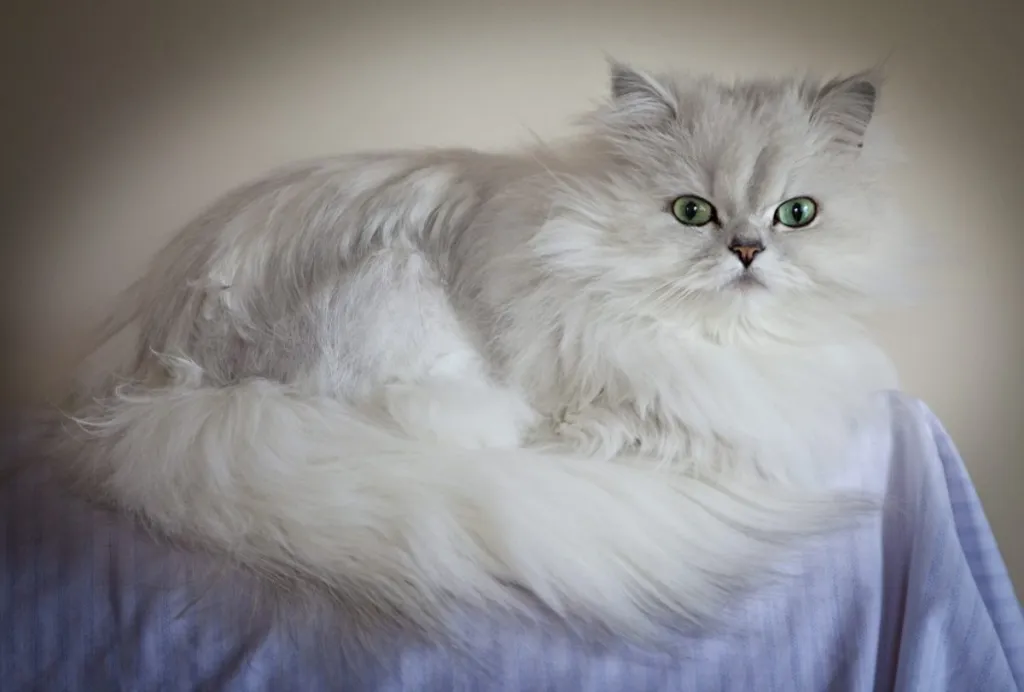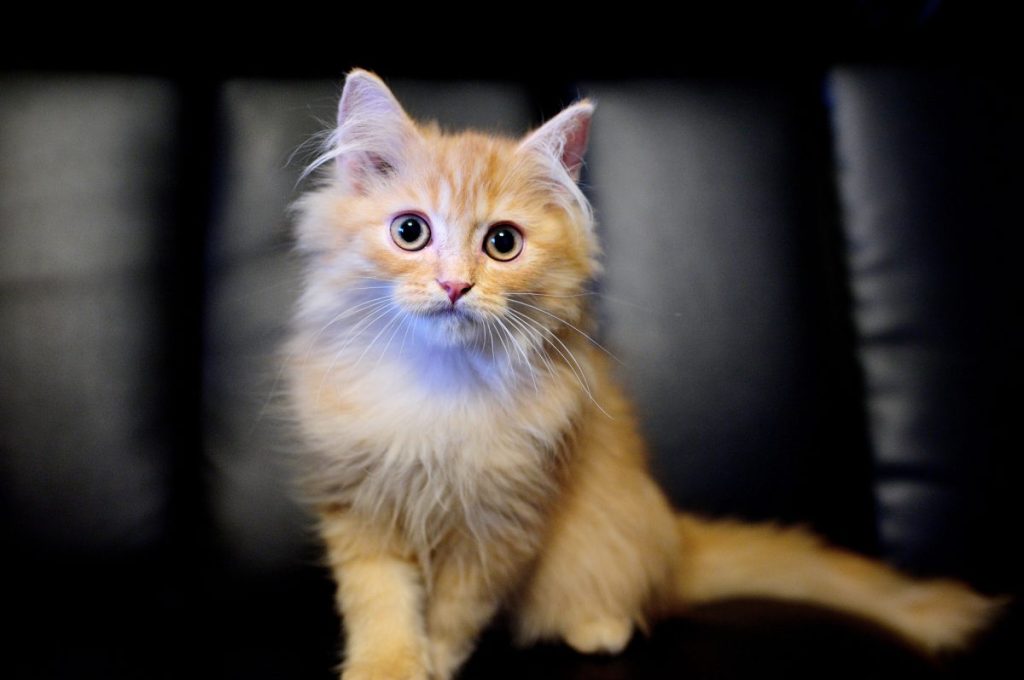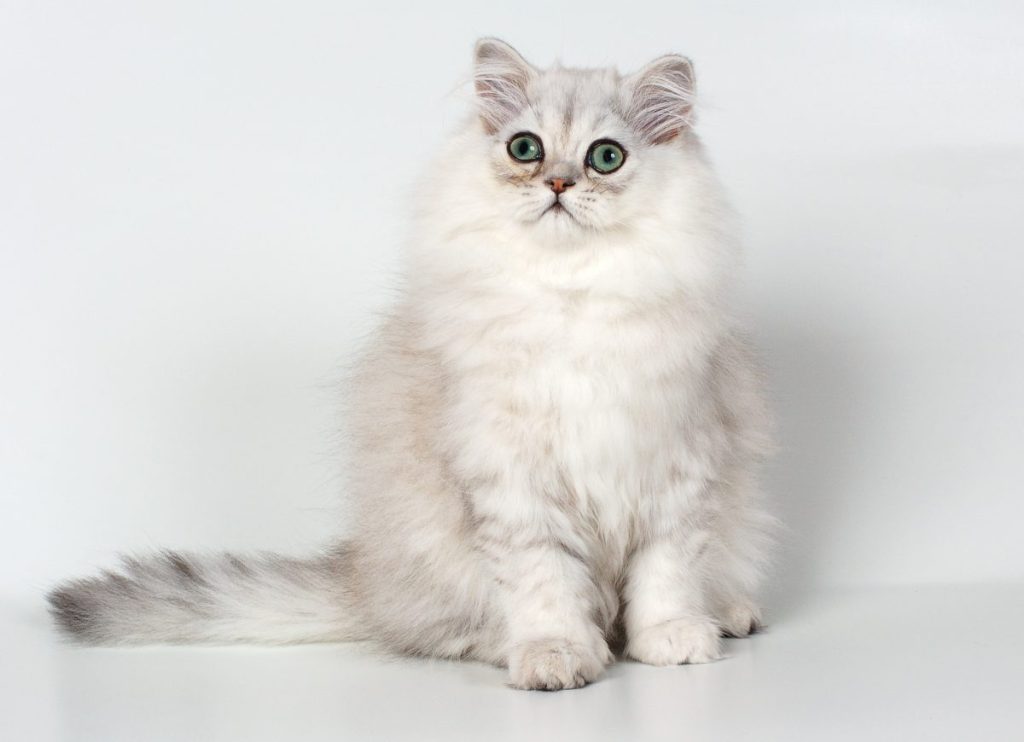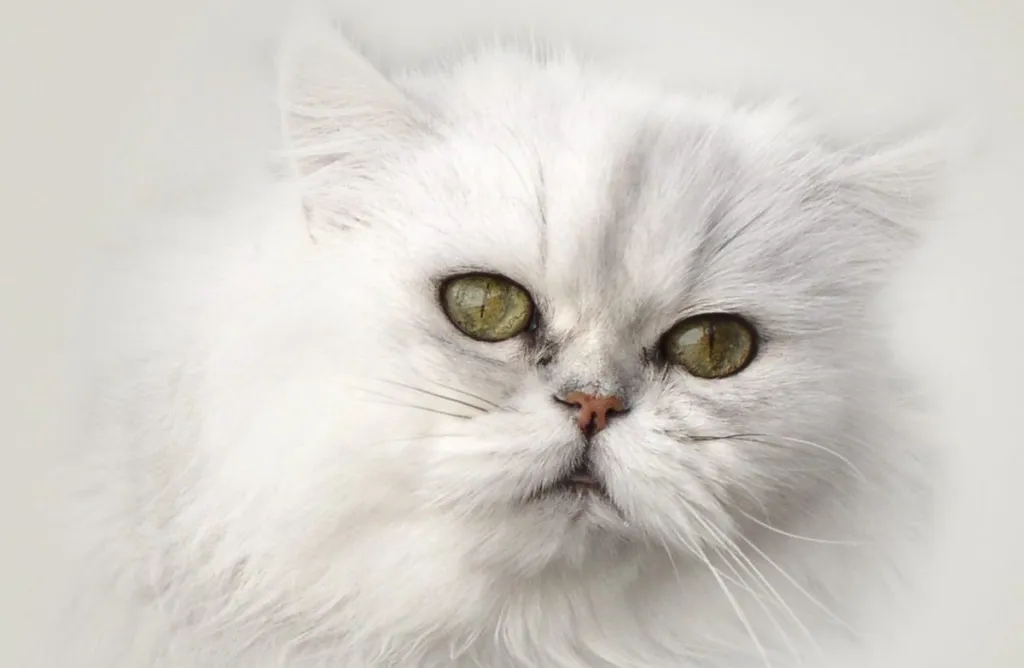The Chinchilla cat, also called the Chinchilla Persian, is a Persian cat breed known for their distinctive white-silvery fur coat and bright green eyes. This elegant cat only comes in one color —a striking white that fades into silver at the tips. Luxurious and soft, their coat and round eyes give them an especially striking appearance. In addition to their good looks, Chinchilla cats are prized for their sweet, affectionate temperaments. They are loving companions who are the true embodiment of lap cats. Chinchilla Persians make wonderful family pets with their charming personalities and eye-catching appearance.
The Chinchilla cat personality is also easygoing and quiet. This breed is known to form strong bonds with their owners. Despite their regal appearance, Chinchilla Persians aren’t the reserved type. They thrive on human interaction and are happiest when they can spend time near their people. Of course, like all cats, they’re also perfectly content to spend solo time napping in a sunny corner! Maintaining the Chinchilla cat’s distinctive, long coat requires regular grooming to prevent matting and keep it in prime condition. Like most cats, they usually care of their own grooming needs, but you may need to help them brush hard-to-reach places.
It’s always advisable to prioritize adopting from rescue organizations or shelters to provide a loving home to a cat in need. However, choosing a reputable breeder is crucial to purchasing a Chinchilla Persian kitten. Conduct thorough research to ensure that the breeder follows ethical practices and prioritizes the well-being of their cats. Reputable Chinchilla cat breeders prioritize the health and temperament of their cats, conduct necessary health screenings, and provide a nurturing environment for the kitties. This active approach ensures you bring home a healthy and happy kitty while discouraging unethical breeding practices.
Quick Facts
- Origin: Late 19th Century England
- Size: Medium (8-12 pounds)
- Breed Group: Longhair (Persian)
- Lifespan: 12-15 years
- Coat: Luxurious pure white longhair with a unique silvery-green tipping
- Temperament: Gentle, affectionate, calm, dignified, playful when young, enjoys lounging and attention.
- Exercise Needs: Low – appreciates playtime but is content with quiet cuddles.
- Training: Can be trained with patience and positive reinforcement, more independent than some cat breeds.
- Grooming: Daily brushing is essential to prevent matting, especially with their long, thick fur.
- Health: Generally healthy but prone to some genetic conditions like brachycephalic syndrome (due to flat face) and polycystic kidney disease.
- The Fancy Feast cats have always been Chinchilla Persians, specifically from the Dearheart line.
- A Chinchilla Cat is featured in the movie “The Eyes of Tammy Faye” during an apology scene. It is based on the real cat owned by Tammy Faye and Jim Bakker.
Chinchilla Cat Pictures



-
Affectionate with Family
Some cat breeds are typically independent and aloof, even if they’ve been raised by the same person since kittenhood; others bond closely to one person and are indifferent to everyone else; and some shower the whole family with affection. Breed isn’t the only factor that goes into affection levels; cats who were raised inside a home with people around feel more comfortable with humans and bond more easily.

See Cats Less Affectionate with Family -
Amount of Shedding
If you’re going to share your home with a cat, you’ll need to deal with some level of cat hair on your clothes and in your house. However, shedding does vary among the breeds. If you’re a neatnik, you’ll need to either pick a low-shedding breed or relax your standards. This furniture cover can make it easier to clean up cat hair and keep it off your sofa!
-
General Health
Due to poor breeding practices, some breeds are prone to certain genetic health problems. This doesn’t mean that every cat of that breed will develop those diseases; it just means that they’re at an increased risk. If you’re looking only for purebred cats or kittens, it’s a good idea to find out which genetic illnesses are common to the breed you’re interested in.
-
Potential for Playfulness
Some cats are perpetual kittens—full of energy and mischief—while others are more serious and sedate. Although a playful kitten sounds endearing, consider how many games of chase the mouse-toy you want to play each day, and whether you have kids or other animals who can stand in as playmates. A classic wand cat toy like this one is perfect for playful felines!
-
Tendency to Vocalize
Some breeds sound off more often than others with meows, yowls, and chattering. When choosing a breed, think about how the cat vocalizes and how often. If constant “conversation” drives you crazy, consider a kitty less likely to chat.
-
Kid-Friendly
Being tolerant of children, sturdy enough to handle the heavy-handed pets and hugs they can dish out, and having a nonchalant attitude toward running, screaming youngsters are all traits that make a kid-friendly cat. Our ratings are generalizations, and they’re not a guarantee of how any breed or individual cat will behave; cats from any breed can be good with children based on their past experiences and personality.
-
Friendly Toward Strangers
Stranger-friendly cats will greet guests with a curious glance or a playful approach; others are shy or indifferent, perhaps even hiding under furniture or skedaddling to another room. However, no matter what the breed, a cat who was exposed to lots of different types, ages, sizes, and shapes of people as a kitten will respond better to strangers as an adult.
-
Easy to Groom
Some breeds require very little in the way of grooming; others require regular brushing to stay clean and healthy. Consider whether you have the time and patience for a cat who needs daily brushing. You should definitely pick up this awesome de-shedding tool for cats of any hair length!
-
Intelligence
Some cat breeds are reputed to be smarter than others. But all cats, if deprived the mental stimulation they need, will make their own busy work. Interactive cat toys are a good way to give a cat a brain workout and keep them out of mischief. This scratcher cat toy can keep your smart kitty busy even when you’re not home!
-
Pet Friendly
Friendliness toward other household animals and friendliness toward humans are two completely different things. Some cats are more likely than others to be accepting of other pets in the home.
Chinchilla Cat History
The Chinchilla cat breed originated in England in 1882. It is widely believed that the cat was named because their luxurious fur resembles that of the chinchilla. The Chinchilla cat came to be when a stray cat mated with a Persian cat and produced a smoke-colored kitten named Chinnie. Along the way, attempts to produce a silver-hued cat resulted in the Chinchilla we know today.
Professional cat registries like the International Cat Association (TICA) and the Cat Fanciers Association (CFA) recognize the Chinchilla as part of the Persian category. These days, you may find the Chinchilla in shelters or rescue groups’ care. So make sure to consider adoption if you decide this is your breed!
Chinchilla Cat Size
The Chinchilla is a small cat. As is always the case, exact size standards might vary. Most Chinchillas weigh around 8-12 pounds, with the females often being smaller than the males.
Chinchilla Cat Personality
If you’re considering adopting a Chinchilla cat, be prepared for a breed who will want to by your side a lot. These sweet kitties need a lot of attention. They’re not the sort of cat who is reserved, aloof, or independent. In some ways, these cats can be a little more doglike in ways. Initially, this breed might be a little wary of strangers, but they soon love to be around their humans and will form exceptionally loyal bonds.
Naturally, the Chinchilla is a cat that likes to lounge around and relax, so feel free to start planning your TV binge-watching sessions with this breed in mind! While the Chinchilla Persian has picked up a reputation as being laid back and not the most active cat, it’s important to take care of their playful side. Definitely consider adding some interactive toys to the home. If you prefer a peaceful life over noisy environments, you’ll also be glad to hear that the Chinchilla is usually a quiet cat with a very gentle disposition.
Chinchilla Cat Health
Chinchillas are generally considered to be healthy cats–although they can be predisposed to the same conditions that Persian breeds face. As always, it’s important to schedule regular wellness visits with your cat’s vet. Some of the more common health problems Chinchillas suffer from include:
- Dental Issues: Dental issues are common among cats and can lead to various health problems if left untreated. Regular veterinary check-ups, including dental examinations, are essential for early detection and prevention of dental issues.
- Breathing Problems: Brachycephalic syndrome is a condition that affects certain cat breeds with distinctive short-nosed or “brachycephalic” facial features. Breeds prone to this syndrome include Persian cats, Himalayans, and Exotic Shorthairs, among others. Brachycephalic cats have a distinctive appearance characterized by a short skull, flat face, and compressed upper respiratory tract.
- Kidney Failure: Kidney failure, also known as renal failure, is a common and serious health issue in cats. It can occur acutely (sudden onset) or develop gradually over time (chronic). Kidney failure is often associated with aging, but it can affect cats of any age.
As with all cats, it’s important to keep up your Chinchilla’s regular veterinary checkups to detect any health concerns early. Your vet can help you develop a care routine that will keep your cat healthy.
Chinchilla Cat Care
Beyond scheduling yearly wellness visits with your vet, make sure that you pick up a scratching post for your Chinchilla cat’s living environment–this can help promote healthy scratching and keep the cat’s nails in good condition.
Additionally, the Chinchilla’s ears should be examined regularly for signs of dirt building up or possible infection. Talk to your vet about starting a regular teeth brushing regime that will suit your Chinchilla. Your vet can advise you about specific brands and techniques if you haven’t cleaned a cat’s teeth before.
Finally, the Chinchilla is a cat breed that will really appreciate a cat tree or cubby to play and interact with–so definitely make sure you have the space to add one to your home!
Chinchilla Cat Coat Color And Grooming
The Chinchilla is a cat breed that comes in a pure color, although it can give off a silver appearance due to the darker tips of its fur. When it comes to grooming a Chinchilla, you’ll need to commit to to keep the cat’s long hair in good condition and also ward off the chances of mats forming. Use the grooming time as an opportunity to bond with your Chinchilla. Consult with your veterinarian about the ideal number of grooming sessions to partake in every week.
In terms of climate, most Chinchillas are fairly adaptable. Just remember to always make sure that there’s enough shade and fresh water available during the hotter months.
Children And Other Pets
Due to the breed’s gentle nature, the Chinchilla is an excellent choice of cat for households with kids. Just make sure that early socialization takes place and boundaries are properly set on both sides–and supervise early interactions between young children and cats.
When it comes to other household pets, the Chinchilla can get along with many other domestic animals including dogs. Always make sure to supervise early interactions between the new cat and existing pets–sometimes these relationships are very much dependent on the individual pets’ personalities. Ultimately, early socialization really pays off with this breed. Make sure to reward your Chinchilla for good behavior when you bring them home to your family!
Chinchilla Cat Rescue Groups
More Info For You
If you’re also looking for a dog, check out DogTime’s dog breed page!
- Best Cat Names
- Kittens & What To Expect
- Brain Games For Your Cat
- Indoor Exercise For Cats
- Cat Toys
- Cat Carriers
- Choosing A Veterinarian
- Cat Food And Nutrition






